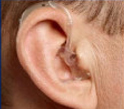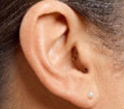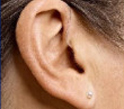Choosing The Right Hearing Aid
There are a number of different styles of hearing aids to choose from depending upon your needs, preferences and lifestyle. Watch this short video to learn more about how to choose the right hearing aid for you.
Receiver-In-The-Ear (RITE) / Receiver-In-The-Canal (RIC) Hearing Aid
This type of hearing aid consists of the device itself which sits behind the ear and a receiver/speaker secured inside the ear canal with either a rubber earpiece or custom earmold. A thin wire connects the speaker to the device behind the ear.
- Comfort
- Can fit many different types of hearing loss
- Natural hearing correction for mild hearing loss
- Includes many advanced features and customizations
- Direct phone connectivity
- Rechargeable options
- Small and discreet hearing aid, especially when hair covers the behind-the-ear component
- Requires moderate vision and dexterity for wax trap replacement.
- Have mild to severe hearing loss. The hearing aid can be customized with different domes and custom molds to fit many different hearing losses
- Have difficulty hearing on their cell phone
- Want a hearing aid option that is rechargeable versus changing batteries
Behind The Ear Hearing Aid (BTE)
This classic style of hearing aid consists of the device itself which sits behind the ear, a custom ear mold which sits inside the ear canal, and a clear flexible tube that connects the aid to the earmold. Some of the pros and cons are as follows:
- This style can be fit to the widest range of hearing losses
- Power features can be better for people with more severe hearing loss
- It has larger batteries and controls, making it easier to use for someone with vision or dexterity problems
- Sturdy design
- Easy to clean
- Tubing needs periodic changing (every 4-6 months) in clinic
- Requires slightly different positioning of landline telephone
- Have severe-to-profound hearing loss
- Have poor dexterity
- Have widely fluctuating hearing levels
- Have recurrent moisture or damage issues with their hearing aids

In-The-Ear (ITE)
This type of hearing aid and those that follow are housed completely within the outer ear. There are no parts behind the ear. Some pros and cons of this style are:
- Can fit more severe hearing losses than CIC/IIC below
- Landline telephones can be used in their usual manner
- Can be less comfortable than RIC / RITE style for patients with sensitive ears
- Less suitable for patients with tinnitus (ringing in the ears)
- Desire a smaller and more discrete instrument than the ITE style, but still need power to accommodate their hearing loss.

In-The-Canal (ITC)
An ITC hearing aid is about one-half the size of the In-The-Ear hearing aid. It can be used for mild to severe hearing losses.
- Can fit more severe hearing losses than CIC/IIC below
- Landline telephones can be used in their usual manner
- Can be less comfortable than RIC / RITE style for patients with sensitive ears
- Less ideal for patients with tinnitus (ringing in the ears)
- Desire a smaller and more discrete instrument than the ITE style, but still need power to accommodate their hearing loss

Completely-In-The-Canal (CIC) and Invisible-In-The-Canal (IIC)
The CIC and IIC hearing aid fits completely within the ear canal and is the least visible of all the hearing aid styles. The IIC aid fits completely within the ear canal slightly smaller and closer to the eardrum than a CIC.
- It is virtually invisible and therefore the most cosmetically appealing instrument
- Landline telephones can be used in their usual manner
- The microphone is located in a more natural sound-gathering position (at or slightly inside the ear canal opening) which allows the outer ear to provide more high-frequency emphasis and enhanced localization
- Shorter battery life
- Good dexterity and vision is required for battery change and care/maintenance.
- Can have shorter lifetime due to microphone being in the ear canal near moisture and earwax
- Desire a small and more discreet instrument
- Use a landline telephone often

Open Fitting
Open fitting hearing aids are worn behind the ear and have a clear tube that goes into the ear canal. A probe on the end brings the sound into the ear canal.
- It works with the natural shape of the ear to amplify sound.
- Because it does not plug up the ear canal, it sounds more natural and is the most comfortable style.
- It is surprisingly less conspicuous than most other styles.
- Patients can use the telephone without any problems.
- Not suitable for more severe hearing losses.
- Have a high frequency hearing loss.
- Desire a smaller and more discreet instrument.
- Use the telephone often and need amplification for telephone conversation.
- Are bothered by the occlusion effect.

Lyric – 100% Invisible Hearing Aid
Lyric is the world’s first and only 100% invisible extended-wear hearing device. The device is comfortably placed in the ear canal. No surgery or anesthesia is required. Unlike many other hearing devices, Lyric is positioned deep inside the ear canal, so it uses your ear’s anatomy to provide exceptional sound. Lyric is programmed for your specific hearing needs. You can adjust the settings and volume on your device as needed, as well as turn the device on and off if desired.
- Can be used 24 hours a day, seven days a week, for 2-4 months.
- Lyric is 100% invisible, allowing you to enjoy all the benefits of better hearing without anyone knowing you’re using a hearing device.
- No batteries to replace, no repairs, no lost hearing aids. Just visit your Lyric Hearing Professional’s office as needed to receive new devices with the latest Lyric technology
- Not everyone is a candidate for Lyric
- Wearers cannot swim or skydive while wearing the device
- Requires office visits (every 2 – 4 months) to replace the device
To learn more about Lyric, visit their website at https://www.phonak.com/us/en/hearing-aids/lyric-invisible-hearing-aids.html
